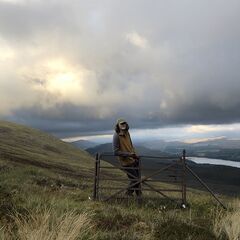The Cairngorms

Enhancing Habitats in the Cairngorms
Our research will work towards sustainable landscape solutions in the Cairngorms, building knowledge and evidence about the landscape. We are working closely with the Cairngorms Connect Partnership, to complement and support their 200-year vision to expand and restore habitats in the Cairngorms National Park.
Our work together will build on their already extensive science and monitoring research programme, bringing new methods and techniques to further increase the understanding of landscape regeneration in upland areas of the UK.
The Cairngorms Connect Partnership:
Cairngorms Connect is the UK's largest habitat restoration partnership spanning 600 square kilometers in the Scottish Highlands - That's 13% of the Cairngorms National Park.
Please allow social and marketing cookies to show embedded content.
Comprised of four key landowners:
- Forestry and Land Scotland: responsible for managing Scotland's national forests and land.
- The RSPB Scotland, a UK charity focused on nature conservation.
- NatureScot, Scotland's nature agency dedicated to protecting and promoting natural heritage.
- Wildland Ltd, owned by Anders Povlsen, with a commitment to landscape-scale conservation in the Scottish Highlands
Our Objectives Align:
Together, the CLR objectives align seamlessly with the Cairngorms Connect vision. This convergence sets the stage for a collaborative project within the Cairngorms National Park, where we can pool resources, expertise, and efforts to support landscape regeneration and contribute to sustainable, resilient, and inclusive solutions across the landscape.
Our Research:
Working closely with the Cairngorms Connect expertise and their ongoing projects, our collaborative aim is to explore four crucial areas, leveraging our partnership to create meaningful impact:
- Evaluating the impact of conservation efforts on Greenhouse Gas Emissions
- Establishing new approaches to meet the Scottish Governments objectives in monitoring biodiversity
- Explore, analyse and balance trade offs between conservation efforts and gaining stakeholder support.
- Make nature restoration beneficial to people living and working in the Cairngorms.
1. Exploring Conservation Management for Greenhouse Gas Reductions in Cairngorms Connect Regions:
We will explore how nature-based solutions (NbS) could cut greenhouse gas emissions, aiding net zero goals. Specifically, we are investigating the impact of deer management on woodland growth, peatland restoration, and plantations. The aim is to understand emission reductions and assess carbon finance viability in line with woodland and peatland carbon codes.
2. Enhancing Nature Recovery Monitoring and Assessing Effective Interventions:
The Scottish government has mandated Cairngorms National Park to monitor its biodiversity and deliver a nature index that tracks recovery. Exploring lidar for annual forest and peatland health checks, our 380 km² Cairngorms Connect survey in 2023 demonstrates lidar's nature recovery applications. We will further integrate other emerging approaches including eDNA and bioacoustics into our monitoring; applying our approaches to evaluate the effects of land management changes on species.
3. Assessing Impacts: Alternative Land Management on Biodiversity, Greenhouse Gases, Flood Risk, Water Quality, Tourism, and Ecosystem Services
Together we will analyse and balance trade-offs, comparing outcomes like those from plantation forestry versus natural woodland growth. Our goal is a framework exploring various options to gain multi-stakeholder support. We'll consider scenarios with different levels of each practice, their spatial and temporal impact, and how outcomes evolve over time in response to these interventions.
4. Emphasising Social, Cultural, and Economic Aspects in Landscape Regeneration
We will conduct a comprehensive study on making nature restoration beneficial for people. Involving economic aspects like land values and livelihoods, assessing perceptions and attitudes towards landscapes, engaging in consultations on landscape scenarios, identifying eco-social practices and collaborating on a community regeneration toolkit for ongoing use in the Cairngorms and similar landscape regeneration projects.
CLR Spotlight on Liam Wakefield and their work with restoring Scotland's native woodlands:
Ancient native woodlands in Scotland are severely degraded due to historical human activity and current threats such as deer overpopulation. However, the processes underlying their natural regeneration are poorly understood, leading to a great deal of uncertainty in how these woodlands will look in the next 200 years. Liam Wakefield, a PhD student in the Department of Plant Sciences, is investigating the factors which control the natural regeneration of woodlands, such as browsing intensity and seed dispersal. They are also working to more accurately quantify the current extent of regeneration in the Highlands, and the benefits of carbon sequestration associated with natural woodland expansion.
What's Next?
The work that we do within the Cairngorms, in partnership with Cairngorms Connect will feed into a larger picture of differing landscapes within the UK alongside our work in The Fens and The Lake District. Our goal is to revolutionise landscape regeneration, taking a holistic view, providing knowledge to regenerate the British countryside by enabling resilient, inclusive, and sustainable solutions.






